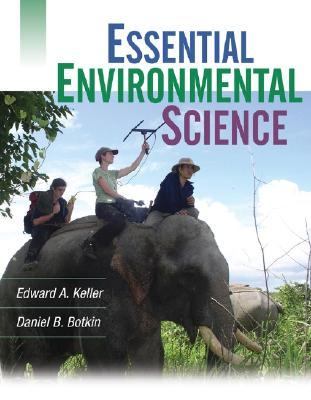5397595
9780471704119
Essential Environmental Science
by Daniel B. Botkin, Edward A. Keller
About this item
- Condition: Good
- Provider: oneplanetbooks Contact
- Provider Rating: 91%
- Ships From: Columbia, MO
- Shipping: Standard, Expedited
- Comments: Ships in a BOX from Central Missouri! May not include working access code. Will not include dust jacket. Has used sticker(s) and some writing or highlighting. UPS shipping for most packages, (Priority Mail for AK/HI/APO/PO Boxes).

About this item
- Condition: Good
- Provider: GoTextbooks Contact
- Provider Rating: 78%
- Ships From: Little Rock, AR
- Shipping: Standard

Product details
- ISBN-13: 9780471704119
- ISBN: 0471704113
- Edition: 1
- Publication Date: 2007
- Publisher: Wiley
AUTHOR
1 Customer Product ReviewsSUMMARY
There are about 30,000 Asian elephants in the wild. What are the causes behind the decline? What can be done about saving the elephant population from extinction while also benefiting the growing human population?Dr. Melissa Songer and Danielle Shanahan, scientists from teh Conservation GIS Lab at the Smithsonian National Zoological Park, Track wild Asian elephants in the Bago Yoma, Myanmar, with the help of a timber elephant and his mahout, a Hindi word for keeper of elephants. Satellite collars are deployed on 4 elephants in Myanmar, allowing scientists to remotely monitor elephant movements, even through dense forest and steep terrain. Data from the collars provides insight into the requirements of their habitat, dynamics, of their seasonal movements, and home range size. The land of Bago Yoma shown here is steadily being converted to agriculture to help feed the growing human population in the area. As people encroach on elephant habitat, there is an increase in human-elephant conflicts that are detrimental to both sides. Analysis of elephant movement data and community assessments will help to develop and implement new land-use strategies that will minimize conflict and benefit elephants and people.This work is part of a larger research program led by Dr. Peter Leimgruber, assessing the ecology and conservation status of Asian elephants in Myanmar.Daniel B. Botkin is the author of 'Essential Environmental Science', published 2007 under ISBN 9780471704119 and ISBN 0471704113.
[read more]Customer reviews
{{post.questionOneAnswer|unescape}} {{post.questionTwoAnswer|unescape}}
[read more]


